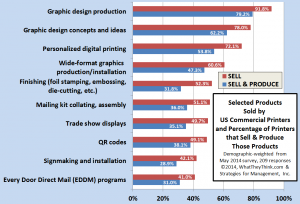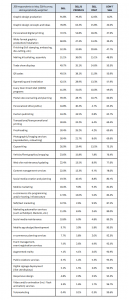What services do printers offer, and which of those additional services do they produce themselves?
This was one of our questions in the May 2014 survey of (209 US commercial printer respondents). A few comments about methodology are in order. The list of services was supplied in the questionnaire; respondents were not asked which services they offer in an open-end question. The list was not intended to be exhaustive. The list can be seen in the table at the end of this blogpost. In terms of the percentages in the tables, everything is weighted according to the industry demographics as published by the Bureau of Labor Statistics in the latest County Business Patterns Report. There are differences by the size of business, and we will report those in future posts. The demographic adjustment allows us to present these data as "the industry at large." Also note that these data do not measure the dollar volume of these services, just whether or not they are offered. It's hard to categorize the services, but intent of the list was to basically be "non-offset" services. There's no precise way to describe the list, however, it's just a collection of services of many types.
The most common service is graphic design production, which is not a surprise. Most every printer, large and small, offers these services. About 90% offer them, and about 80% do them in-house. The difference between graphic design and graphic design production is significant, as graphic design involves the use of idea and concept development. Therefore, it's not a surprise that while 78% offer graphic design in its conceptual sense and that only 62% do that work in house. The rest is outsourced, usually to a freelance designer. (click chart to enlarge)

Personalized digital printing was third on the list. No specifics about sophistication were asked, so it could be as easy as a new name and address on every sheet, or a complete data-base-driven insertion of high quality graphics. Wide format was offered by 60% of the respondents, with almost half doing that work in-house.
The lack of digital media in the top ten may or may not be a concern, but they do start appearing after the top ten items. We should note that digital media production is a competitive marketplace, and might actually be more competitive than selling print. It's one of those things that is easy to admonish printers for lack of initiative in the area, but not as easy to do as is commonly believed. Digital media capabilities are produced by a wider range of people and businesses with extreme levels of competence, and it's often difficult for potential buyers to discern the best providers. This is why it's essential for print businesses that offer these services to use the services in their own businesses as demonstrations of their skills.
In future posts we'll review how these services vary by size of business and also the differences between those printers that claim to be marketing services providers and those that do not.
Below is the table that indicates the range of services we had in the questionnaire. (click table to enlarge)

# # #
 Personalized digital printing was third on the list. No specifics about sophistication were asked, so it could be as easy as a new name and address on every sheet, or a complete data-base-driven insertion of high quality graphics. Wide format was offered by 60% of the respondents, with almost half doing that work in-house.
The lack of digital media in the top ten may or may not be a concern, but they do start appearing after the top ten items. We should note that digital media production is a competitive marketplace, and might actually be more competitive than selling print. It's one of those things that is easy to admonish printers for lack of initiative in the area, but not as easy to do as is commonly believed. Digital media capabilities are produced by a wider range of people and businesses with extreme levels of competence, and it's often difficult for potential buyers to discern the best providers. This is why it's essential for print businesses that offer these services to use the services in their own businesses as demonstrations of their skills.
In future posts we'll review how these services vary by size of business and also the differences between those printers that claim to be marketing services providers and those that do not.
Below is the table that indicates the range of services we had in the questionnaire. (click table to enlarge)
Personalized digital printing was third on the list. No specifics about sophistication were asked, so it could be as easy as a new name and address on every sheet, or a complete data-base-driven insertion of high quality graphics. Wide format was offered by 60% of the respondents, with almost half doing that work in-house.
The lack of digital media in the top ten may or may not be a concern, but they do start appearing after the top ten items. We should note that digital media production is a competitive marketplace, and might actually be more competitive than selling print. It's one of those things that is easy to admonish printers for lack of initiative in the area, but not as easy to do as is commonly believed. Digital media capabilities are produced by a wider range of people and businesses with extreme levels of competence, and it's often difficult for potential buyers to discern the best providers. This is why it's essential for print businesses that offer these services to use the services in their own businesses as demonstrations of their skills.
In future posts we'll review how these services vary by size of business and also the differences between those printers that claim to be marketing services providers and those that do not.
Below is the table that indicates the range of services we had in the questionnaire. (click table to enlarge)
 # # #
# # #














